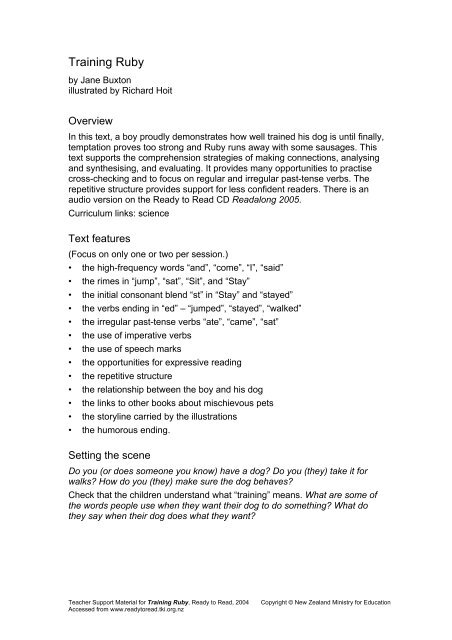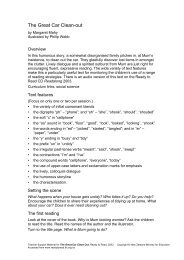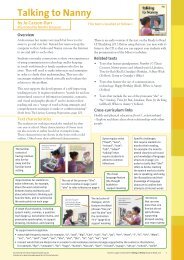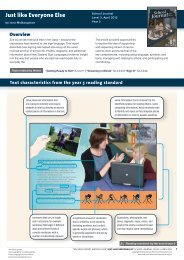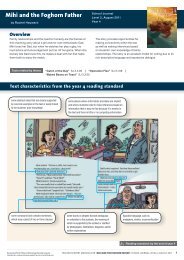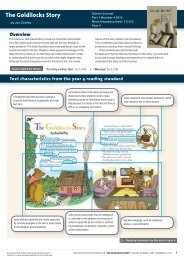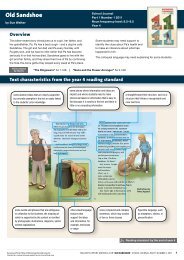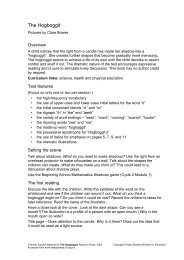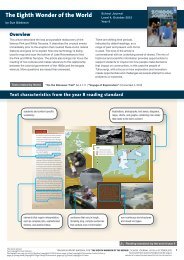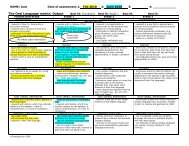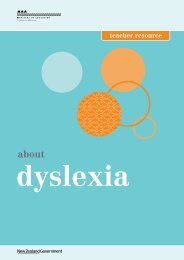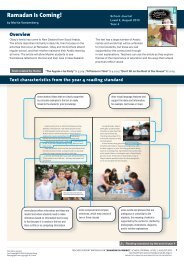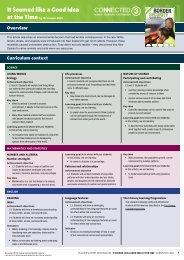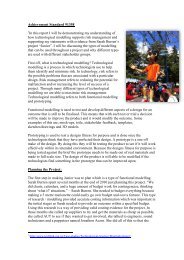Training Ruby TSM Red (PDF 70KB) - Literacy Online
Training Ruby TSM Red (PDF 70KB) - Literacy Online
Training Ruby TSM Red (PDF 70KB) - Literacy Online
Create successful ePaper yourself
Turn your PDF publications into a flip-book with our unique Google optimized e-Paper software.
<strong>Training</strong> <strong>Ruby</strong>by Jane Buxtonillustrated by Richard HoitOverviewIn this text, a boy proudly demonstrates how well trained his dog is until finally,temptation proves too strong and <strong>Ruby</strong> runs away with some sausages. Thistext supports the comprehension strategies of making connections, analysingand synthesising, and evaluating. It provides many opportunities to practisecross-checking and to focus on regular and irregular past-tense verbs. Therepetitive structure provides support for less confident readers. There is anaudio version on the Ready to Read CD Readalong 2005.Curriculum links: scienceText features(Focus on only one or two per session.)• the high-frequency words “and”, “come”, “I”, “said”• the rimes in “jump”, “sat”, “Sit”, and “Stay”• the initial consonant blend “st” in “Stay” and “stayed”• the verbs ending in “ed” – “jumped”, “stayed”, “walked”• the irregular past-tense verbs “ate”, “came”, “sat”• the use of imperative verbs• the use of speech marks• the opportunities for expressive reading• the repetitive structure• the relationship between the boy and his dog• the links to other books about mischievous pets• the storyline carried by the illustrations• the humorous ending.Setting the sceneDo you (or does someone you know) have a dog? Do you (they) take it forwalks? How do you (they) make sure the dog behaves?Check that the children understand what “training” means. What are some ofthe words people use when they want their dog to do something? What dothey say when their dog does what they want?Teacher Support Material for <strong>Training</strong> <strong>Ruby</strong>, Ready to Read, 2004Accessed from www.readytoread.tki.org.nzCopyright © New Zealand Ministry for Education
The first readingLook at the cover. What is the boy doing? What do you think the title mightbe? If the word was “training”, what letters would you expect to see at thebeginning? How would it end? You may need to tell the children <strong>Ruby</strong>’s name.Read the names of the author and the illustrator.Title page – Listen to the children read the title again. What does thisillustration tell us about <strong>Ruby</strong>?Listen to the children read the text themselves, offering support as necessary.Page 2 – What do you think the boy is telling <strong>Ruby</strong> to do?Page 3 – Is the boy pleased with <strong>Ruby</strong>? How do you know?Page 4 – If the children say “sit” or “sitted” for “sat”, prompt them to crosscheckusing the “at” rime. Where do you think they’re going?Page 6 – Some children may say “Stop” or “Sit” for “Stay”. Prompt them tocross-check. Look at the ending. Could this word be “Stop”? Is <strong>Ruby</strong> sittingdown? Why does the boy want <strong>Ruby</strong> to stay?Page 8 – If necessary, support the children with the irregular verb “came”.Does “comed” sound right?Page 12 – Note that the children discover <strong>Ruby</strong>’s misbehaviour before the boydoes.Page 13 – How would the boy say this? Encourage expressive reading!Is <strong>Ruby</strong> a good girl? What will the boy do now? Why is it important to train adog?Ideas for revisiting the text(Choose only one or two per session.)Listen to the children reread the text, observing their use of strategies andtheir ability to read with expression. Check that they’re articulating the “ed”endings.Locate some of the high-frequency words in the text. Find me the word “and”on page 2. How do you know that’s the right word? Can you find it on page 4?Can you write “and” without looking at the book?Focus on the initial consonant blend in “Stay” and “stayed”. Make a list ofother words that start with “st”.Have the children generate new words by substituting initial consonants orblends for the “at”, “ay”, “it”, or “ump” rimes. Write the words in a list so thechildren can see the pattern. Read the list together. Which word is “rat”? Howdo you know?Show the children how they can apply their knowledge of “ed” verbs to theirwriting. Write the word “walk” on the whiteboard. Show me how you can make“walk” into “walked”. Find the word “walked” on page 2. What letters can yousee at the end? Were you right? Now, how do you change “stay” intoTeacher Support Material for <strong>Training</strong> <strong>Ruby</strong>, Ready to Read, 2004Accessed from www.readytoread.tki.org.nzCopyright © New Zealand Ministry for Education
“stayed”? Repeat the process of having the children visualise and confirmseveral times. Have the children add “ed” to some verbs that aren’t in the text.During subsequent writing sessions, remind the children to draw on whatthey’ve learnt about adding “ed”.Reread the pages that include irregular past-tense verbs. Remind the childrenthat not all verbs can have “ed” added to them and that they will need to drawon their knowledge of spoken English. Does “sitted” sound right? Practisemaking up some oral sentences together that use the verbs “ate”, “came”, or“sat”.Talk about the purpose of the speech marks in the story. How do you knowwhat the boy said? Talk about the use of exclamation marks to show thereader how to make the words come to life.Ask the children to find the words where the boy tells <strong>Ruby</strong> what to do. Youcould introduce the term “imperative verbs”. Remind the children of the use ofimperative verbs when writing instructions.Browse through the illustrations together, encouraging the children to tell thestory of the boy’s journey with <strong>Ruby</strong>. Encourage the children to compare thestory with their own experiences of dogs.Suggestions for further tasksListen to the audio version on the CD Readalong 2005.Read or reread Dog (<strong>Red</strong>) and compare the characters of Dog and <strong>Ruby</strong>.Read or reread The New Cat (Magenta) and Greedy Cat is Hungry (<strong>Red</strong>) andenjoy the connections to <strong>Ruby</strong>’s behaviour.Have the children write or draw the next part of the story.Have the children draw pictures of themselves training a dog. Add speechbubbles, using commands from the text.Innovate on the text, adding in new commands for <strong>Ruby</strong> and her trainer. Forexample, “I said, ‘Run’, and <strong>Ruby</strong> ran.”Make magnetic letters available for the children to generate their own rhyminglists using selected rimes from the story.Teacher Support Material for <strong>Training</strong> <strong>Ruby</strong>, Ready to Read, 2004Accessed from www.readytoread.tki.org.nzCopyright © New Zealand Ministry for Education


